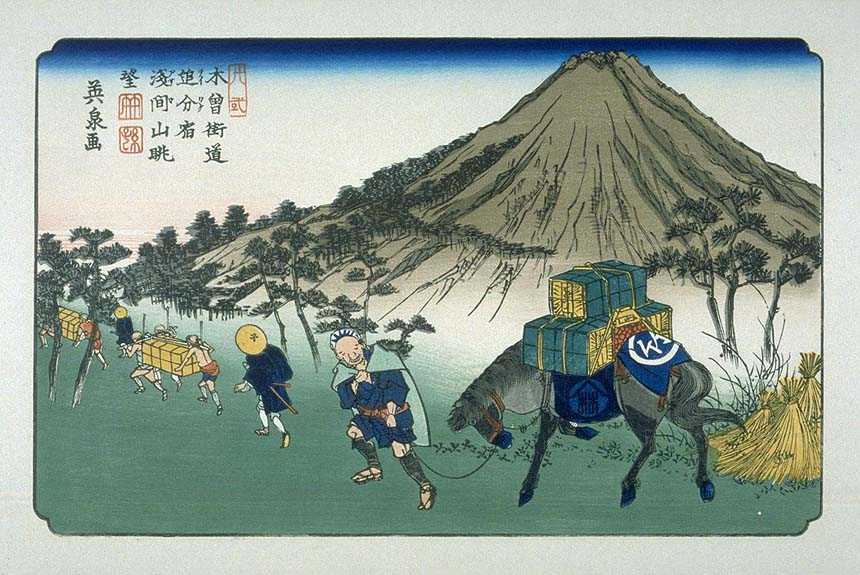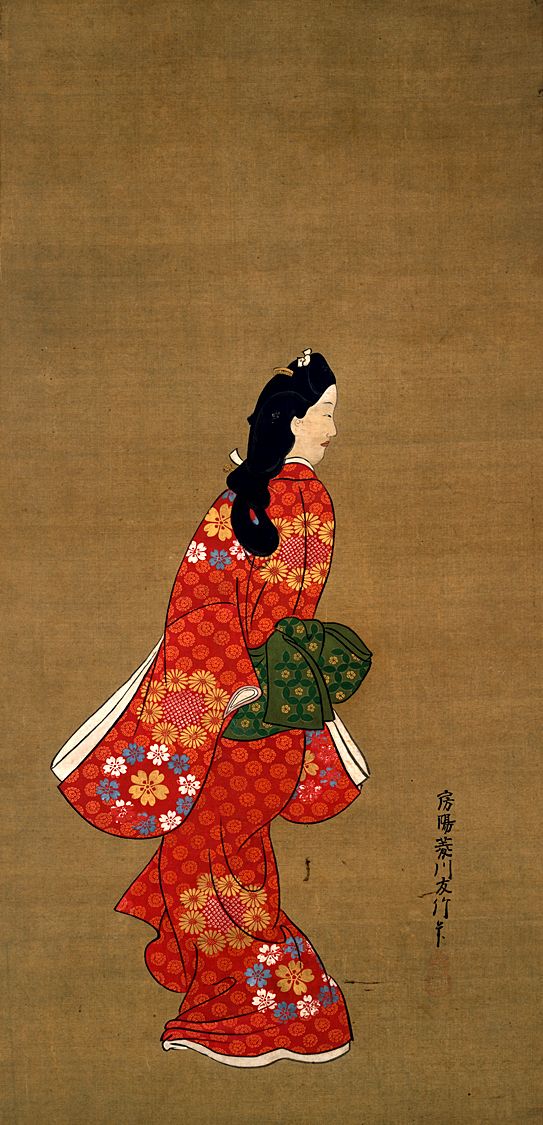|
ŇĆiso-juku
was the eighth of the fifty-three stations (''shukuba'') of the TŇćkaidŇć. It is located in the present-day town of ŇĆiso, located in Naka District, Kanagawa Prefecture, Japan. History ŇĆiso-juku was established in 1601, along with the other original post stations along the TŇćkaidŇć, by Tokugawa Ieyasu. In 1604, Ieyasu planted a colonnade of pine and hackberry trees, to provide shade for the travelers.TŇćkaidŇć Oiso Town Hall. Accessed November 5, 2007. The classic print by (''HŇćeidŇć'' edition) from 1831‚Äď1834 depicts travelers in straw raincoats entering a village ... [...More Info...] [...Related Items...] OR: [Wikipedia] [Google] [Baidu] |
53 Stations Of The TŇćkaidŇć
The are the rest areas along the TŇćkaidŇć (road), TŇćkaidŇć, which was a coastal route that ran from Nihonbashi in Edo (modern-day Tokyo) to SanjŇć ŇĆhashi in Kyoto.. There were originally 53 government shukuba, post stations along the TŇćkaidŇć, where travelers had to present traveling permits at each station if wanting to cross. In 1619, the ŇĆsaka KaidŇć (Ś§ßťė™Ť°óťĀď) was developed to extend the TŇćkaidŇć so that it would reach KŇćraibashi in modern-day Osaka. Instead of going to SanjŇć ŇĆhashi, travelers would leave from ŇĆtsu-juku and travel towards Fushimi-juku (TŇćkaidŇć), Fushimi-juku. Because of the addition of these four post towns, the TŇćkaidŇć is occasionally referred to as having 57 stations. Another name for this extension was KyŇćkaidŇć (šļ¨Ť°óťĀď). The inland NakasendŇć also started at Nihonbashi, and converged with the TŇćkaidŇć at Kusatsu-juku. Shio no Michi intersected with the TŇćkaidŇć at Okazaki-shuku. Stations of the TŇćkaidŇć File:NihombashiDat ... [...More Info...] [...Related Items...] OR: [Wikipedia] [Google] [Baidu] |
Odawara-juku
was the ninth of the fifty-three stations of the TŇćkaidŇć. It is located in the present-day city of Odawara, Kanagawa Prefecture, Japan. It was the first post station in a castle town that travelers came to when they exited Edo (modern-day Tokyo) in Edo period Japan. History Odawara-juku was established between the mountains of Hakone and Sagami Bay, near Odawara Castle.Odawara Area Highlights . Kanagawa Prefectural Tourist Association. Accessed December 10, 2007. Located near the banks of the Sakawa River, Odawara-juku was a famous post station. It is said to hold the remains of Lady Kasuga
was a Japanese noble lady and politician from a prominent Japanese samur ...
[...More Info...] [...Related Items...] OR: [Wikipedia] [Google] [Baidu] |
Hiratsuka-juku
was the seventh of the fifty-three stations (''shukuba'') of the TŇćkaidŇć. It is located in the present-day city of Hiratsuka, Kanagawa Prefecture, Japan. History Hiratsuka-juku was first established in 1601, at the orders of Tokugawa Ieyasu.11 Hiratsuka-juku Hiratsuka City Museum. Accessed November 5, 2007. In 1651, though, it merged with part of the nearby village of Yawata. In 1655, it was renamed "Shinhiratsuka-juku." During a in 1843, the post station was found to have a population of 2,114 people and 443 houses, which included one '''', 1 ... [...More Info...] [...Related Items...] OR: [Wikipedia] [Google] [Baidu] |
Izu Peninsula
The is a mountainous peninsula with a deeply indented coastline to the west of Tokyo on the Pacific Ocean, Pacific coast of the island of Honshu, Japan, the largest of the four main islands of Japan. Formerly known as Izu Province, Izu peninsula is now a part of Shizuoka Prefecture. The peninsula has an area of and its estimated population in 2005 was 473,942 people. The peninsula's populated areas are located primarily on the north and east. Geology Tectonically, the Izu peninsula results from the Philippine Sea Plate colliding with the Okhotsk Plate at the Nankai Trough. The Philippine Sea Plate, the Amurian Plate, and the Okhotsk Plate meet at Mount Fuji, a triple junction. The peninsula itself lies on the Philippine Sea Plate. The southern portion of the peninsula is composed largely of breccia, and the central and northern portions consist of numerous highly eroded volcanoes. The Amagi Mountain Range dominates the center of the peninsula with Mount Amagi () and Mount ... [...More Info...] [...Related Items...] OR: [Wikipedia] [Google] [Baidu] |
Sagami Bay
lies south of Kanagawa Prefecture in Honshu, central Japan, contained within the scope of the Miura Peninsula, in Kanagawa, to the east, the Izu Peninsula, in Shizuoka Prefecture, to the west, and the ShŇćnan coastline to the north, while the island of Izu ŇĆshima marks the southern extent of the bay. It lies approximately southwest of the capital, Tokyo. Cities on the bay include Odawara, Chigasaki, Fujisawa, Kanagawa, Fujisawa, Hiratsuka, ItŇć, Shizuoka, ItŇć, and Kamakura, Kanagawa, Kamakura. History The center of the 1923 Great KantŇć earthquake, Great KantŇć earthquake in 1923 was deep beneath Izu ŇĆshima Island in Sagami Bay. It devastated Tokyo, the port city of Yokohama, and the surrounding prefectures of Chiba Prefecture, Chiba, Kanagawa, and Shizuoka Prefecture, Shizuoka, and caused widespread damage throughout the KantŇć region. The shallow nature of the seabed on the north of the bay, and the funnelling effect of tsunami and typhoon wave energy, contributed to cer ... [...More Info...] [...Related Items...] OR: [Wikipedia] [Google] [Baidu] |
AndŇć Hiroshige
or , born AndŇć TokutarŇć (; 1797 ‚Äď 12 October 1858), was a Japanese ''ukiyo-e'' artist, considered the last great master of that tradition. Hiroshige is best known for his horizontal-format landscape series '' The Fifty-three Stations of the TŇćkaidŇć'' and for his vertical-format landscape series '' One Hundred Famous Views of Edo''. The subjects of his work were atypical of the ''ukiyo-e'' genre, whose typical focus was on beautiful women, popular actors, and other scenes of the urban pleasure districts of Japan's Edo period (1603‚Äď1868). The popular series '' Thirty-six Views of Mount Fuji'' by Hokusai was a strong influence on Hiroshige's choice of subject, though Hiroshige's approach was more poetic and ambient than Hokusai's bolder, more formal prints. Subtle use of color was essential in Hiroshige's prints, often printed with multiple impressions in the same area and with extensive use of '' bokashi'' (color gradation), both of which were rather labor-intensive ... [...More Info...] [...Related Items...] OR: [Wikipedia] [Google] [Baidu] |
Ukiyo-e
is a genre of Japanese art that flourished from the 17th through 19th centuries. Its artists produced woodblock printing, woodblock prints and Nikuhitsu-ga, paintings of such subjects as female beauties; kabuki actors and sumo wrestlers; scenes from history and folk tales; travel scenes and landscapes; Flora of Japan, flora and Wildlife of Japan#Fauna, fauna; and Shunga, erotica. In 1603, the city of Edo (Tokyo), Edo (Tokyo) became the seat of the ruling Tokugawa shogunate. The class (merchants, craftsmen and workers), positioned at the bottom of Four occupations, the social order, benefited the most from the city's rapid economic growth. They began to indulge in and patronize the entertainment of kabuki theatre, geisha, and oiran, courtesans of the YŇękaku, pleasure districts. The term ('floating world') came to describe this hedonistic lifestyle. Printed or painted ukiyo-e works were popular with the class, who had become wealthy enough to afford to decorate their homes wit ... [...More Info...] [...Related Items...] OR: [Wikipedia] [Google] [Baidu] |
Tokugawa Ieyasu
Tokugawa Ieyasu (born Matsudaira Takechiyo; 31 January 1543 ‚Äď 1 June 1616) was the founder and first ''shŇćgun'' of the Tokugawa shogunate of Japan, which ruled from 1603 until the Meiji Restoration in 1868. He was the third of the three "Great Unifiers" of Japan, along with his former lord Oda Nobunaga, Oda Nobunaga and fellow Oda clan, Oda subordinate Toyotomi Hideyoshi. The son of a minor daimyo, Ieyasu once lived as a hostage under daimyo Imagawa Yoshimoto on behalf of his father. He later succeeded as daimyo after his father's death, serving as ally, vassal, and general of the Oda clan, and building up his strength under Oda Nobunaga. After Oda Nobunaga's death, Ieyasu was briefly a rival of Toyotomi Hideyoshi, before declaring his allegiance to Toyotomi and fighting on his behalf. Under Toyotomi, Ieyasu was relocated to the KantŇć region, Kanto plains in eastern Japan, away from the Toyotomi power base in Osaka. He built Edo Castle, his castle in the fishing village of ... [...More Info...] [...Related Items...] OR: [Wikipedia] [Google] [Baidu] |
Celtis
''Celtis'' is a genus of about 60‚Äď70 species of deciduous trees, commonly known as hackberries or nettle trees, in the hemp family Cannabaceae. It has a cosmopolitan distribution. Description ''Celtis'' species are generally medium-sized trees, reaching tall, rarely up to tall. The leaves are alternate, simple, long, Glossary of leaf morphology#ovate, ovate-acuminate, and evenly serrated margins. Diagnostically, ''Celtis'' can be very similar to trees in the Rosaceae and other rose motif families. Small flowers of this monoecious plant appear in early spring while the leaves are still developing. Male flowers are longer and hairy. Female flowers are greenish and more rounded. The fruit is a small drupe in diameter, edible in many species, with a dryish but sweet, sugary consistency, reminiscent of a date palm, date. Taxonomy Previously included either in the elm family (Ulmaceae) or a separate family, Celtidaceae, the APG III system places ''Celtis'' in an expanded hemp ... [...More Info...] [...Related Items...] OR: [Wikipedia] [Google] [Baidu] |
Japan
Japan is an island country in East Asia. Located in the Pacific Ocean off the northeast coast of the Asia, Asian mainland, it is bordered on the west by the Sea of Japan and extends from the Sea of Okhotsk in the north to the East China Sea in the south. The Japanese archipelago consists of four major islands‚ÄĒHokkaido, Honshu, Shikoku, and Kyushu‚ÄĒand List of islands of Japan, thousands of smaller islands, covering . Japan has a population of over 123 million as of 2025, making it the List of countries and dependencies by population, eleventh-most populous country. The capital of Japan and List of cities in Japan, its largest city is Tokyo; the Greater Tokyo Area is the List of largest cities, largest metropolitan area in the world, with more than 37 million inhabitants as of 2024. Japan is divided into 47 Prefectures of Japan, administrative prefectures and List of regions of Japan, eight traditional regions. About three-quarters of Geography of Japan, the countr ... [...More Info...] [...Related Items...] OR: [Wikipedia] [Google] [Baidu] |
Kanagawa Prefecture
is a Prefectures of Japan, prefecture of Japan located in the KantŇć region of Honshu. Kanagawa Prefecture is the List of Japanese prefectures by population, second-most populous prefecture of Japan at 9,221,129 (1 April 2022) and third-densest at . Its geographic area of makes it fifth-smallest. Kanagawa Prefecture borders Tokyo to the north, Yamanashi Prefecture to the northwest and Shizuoka Prefecture to the west. Yokohama is the capital and largest city of Kanagawa Prefecture and the List of cities in Japan, second-largest city in Japan, with other major cities including Kawasaki, Kanagawa, Kawasaki, Sagamihara, and Fujisawa, Kanagawa, Fujisawa. Kanagawa Prefecture is located on Japan's eastern Pacific coast on Tokyo Bay and Sagami Bay, separated by the Miura Peninsula, across from Chiba Prefecture on the BŇćsŇć Peninsula. Kanagawa Prefecture is part of the Greater Tokyo Area, the most populous metropolitan area in the world, with Yokohama and many of its cities being ma ... [...More Info...] [...Related Items...] OR: [Wikipedia] [Google] [Baidu] |





